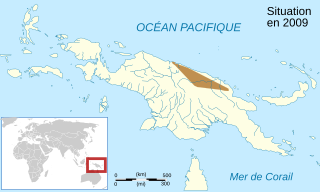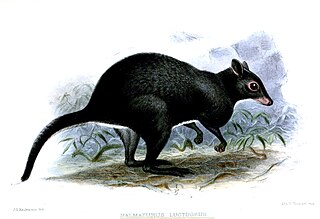
Beccari's free-tailed bat is a species of bat in the free-tailed bat family Molossidae found to Indonesia and Papua New Guinea. It can be found in several habitat types, including savanna, tropical moist forest, and fragmented and urban habitat. It roosts in trees, caves, and buildings in small colonies. This is a common species which is not considered to be threatened. The names Beccari's free-tailed bat or Beccari's mastiff bat once applied to populations in Australia.
St. Aignan's trumpet-eared bat is a species of vesper bat in the family Vespertilionidae. It is found only in Papua New Guinea, and is only endemic to the islands, not the mainland. The species has been recorded on the islands of Fergusson, Vanatinai, Woodlark, and Misima. Its natural habitat is subtropical or tropical dry forests.

Copiula derongo is a species of frog in the family Microhylidae. It is endemic to New Guinea and found in both Indonesia and Papua New Guinea. The specific name derongo refers to its type locality, the village of Derongo in the Western Province. Based on molecular evidence, it was transferred from Austrochaperina to Copiula in 2016.

Copiula guttata is a species of frog in the family Microhylidae. It is endemic to Papua New Guinea and known from around the head of the Gulf of Papua in the Gulf and Chimbu Provinces. The specific name is the Latin adjective guttata that means "spotted" and refers to the dorsal colour pattern of this species. Based on molecular evidence, it was transferred from Austrochaperina to Copiula in 2016.

Copiula rivularis is a species of frog in the family Microhylidae. It is endemic to Papua New Guinea and known from near the Indonesian border east to the Morobe Province; it is expected to occur in the Papua province of Indonesia. The specific name comes from the Latin adjective pertaining to small brooks or streams and refers to the habitat of this species. Based on molecular evidence, it was transferred from Austrochaperina to Copiula in 2016.
Copiula exspectata is a species of frog in the family Microhylidae. It is endemic to West Papua, Indonesia. Its natural habitat is subtropical or tropical moist lowland forests. It is threatened by habitat loss.
Copiula fistulans is a species of frog in the family Microhylidae. It is endemic to Papua New Guinea and occurs in the northeastern part of New Guinea in Morobe and Northern Provinces. Common name Lae Mehely frog has been coined for this species.
Copiula minor is a species of frog in the family Microhylidae. It is endemic to Papua New Guinea. Its natural habitats are subtropical or tropical moist lowland forests and subtropical or tropical moist montane forests. It is threatened by habitat loss.
Copiula oxyrhina is a species of frog in the family Microhylidae. It is endemic to Papua New Guinea. Its natural habitats are subtropical or tropical moist lowland forests, subtropical or tropical moist montane forests, subtropical or tropical seasonally wet or flooded lowland grassland, rural gardens, urban areas, and heavily degraded former forest.
Copiula pipiens is a species of frog in the family Microhylidae. It is known from its type locality, Wirui near Wewak in the north coast of New Guinea, Papua New Guinea, and from the island of Yapen, off the north-western coast of New Guinea, in the West Papua province of Indonesia. The Yapen population might represent a different but closely related species. Common name Wirui Mehely frog has been coined for this species.

Copiula tyleri is a species of frog in the family Microhylidae. It is endemic to northeastern New Guinea and is found in both Western New Guinea and Papua New Guinea. The specific name tyleri honours Michael J. Tyler, Australian herpetologist who have worked extensively with Australian and New Guinean frogs.
Copiula alpestris is a species of frog in the family Microhylidae. It is endemic to Papua New Guinea and known from the Western Highlands, Chimbu, and Eastern Highlands Provinces at elevations of 1,800–2,800 m (5,900–9,200 ft) above sea level. The specific name is a Latin adjective meaning "living in high mountains", in reference to its relatively high-altitude habitats. Based on molecular evidence, the species was transferred from Oxydactyla to Copiula in 2016.
Platymantis bimaculatus is a species of frog in the family Ceratobatrachidae. It is endemic to West Papua, Indonesia.

The gray dorcopsis or gray forest wallaby is a species of marsupial in the family Macropodidae. It is found in West Papua and Papua New Guinea.

The small dorcopsis or lesser forest wallaby is a species of marsupial in the family Macropodidae. It is found in the mountainous interior of West Papua and Papua New Guinea. Its natural habitat is subtropical or tropical dry forests. It is less common than it used to be and the IUCN has assessed it as being "near threatened".

Calaby's pademelon, also known as the alpine wallaby, is a species of marsupial in the family Macropodidae. It is endemic to Papua New Guinea. It is threatened by habitat loss and hunting.

Gilliard's flying fox is a species of flying fox in the family Pteropodidae. In Spanish, the common name is zorro volador de Gilliard. It is endemic to Papua New Guinea. It is known from only three specimens.

The Geelvink Bay flying fox or Geelvink Bay fruit bat is a species of flying fox in the family Pteropodidae. It is endemic to the islands of Yapen, Numfor, and Rani, which lie north of New Guinea in Indonesia's Papua Province. The name comes from Geelvink Bay, now Cenderawasih Bay.
The D'Entrecasteaux Archipelago pogonomys, also known as the D'Entrecasteaux Archipelago tree mouse, is a species of prehensile-tailed rat from the family Muridae that is endemic to Papua New Guinea. It was once considered to be a subspecies of the Large Tree Mouse. Deforestation is posing a threat to the species, but it has been suspected that the species has some degree of tolerance towards disturbance of its habitat.
Gressitt's mosaic-tailed rat is a species of rodent native to Papua New Guinea. Ongoing habitat degradation is a major threat. It is named after the collector, Judson Linsley Gressitt.










